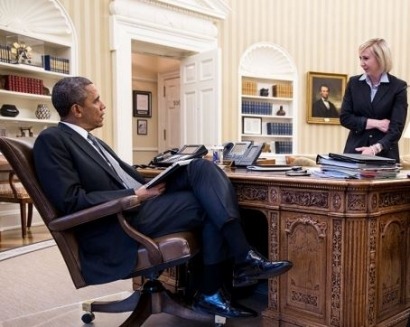
The president unveiled the policy initiatives during a visit to Wal-Mart in Mountain View, California, in part to highlight the commitments score of corporations have made to using power harnessed from the sun to run their facilities.
In addition to Wal-Mart, these entities include firms headquartered not far from where the president spoke: Apple, Google and Yahoo.
The White House also announced that several financial institutions, including Citigroup and Goldman Sachs Group are rolling out "large scale investment and innovative programs" to develop solar and renewable energy installations.
The president's actions also include an initiative The White House says will help community college across the country create 50,000 new solar industry workers by 2020.
In all, President Obama announced more than 300 private and public sector commitments to create jobs and cut carbon pollution by advancing solar deployment and energy efficiency.
The commitments represent more than 850 megawatts of solar deployed – enough to power nearly 130,000 homes – as well as energy efficiency investments that will lower bills for more than 1 billion square feet of buildings.
Additionally, the President announced new executive actions that will lead to $2 billion in energy efficiency investments in Federal buildings; smarter appliances that will cut carbon pollution by more than 380 million metric tons – equivalent to taking 80 million cars off the road for one year – and will save businesses nearly $26 billion on their energy bills.
President Obama had previously said he wants 2014 to be a year of action on renewable energy and has pledged to use the power of his phone and his pen to expand opportunity for all Americans.
Last month, the White House hosted a Solar Summit celebrating cross-sector leadership on solar and calling for commitments to support solar deployment and jobs through the expand use of solar in our homes, businesses, and schools.
The President has also called on private and public sector leaders to join the Better Buildings Challenge and continue improving the efficiency of American commercial, institutional, and multifamily buildings and industrial plants by 20 percent or more over ten years.
Last year, about a quarter of new power generation capacity was from solar – second only to natural gas.
Growing deployment, led in large part by the utility sector, has driven down costs, The White House said.
Building on the success of the Defense Department’s coordinated efforts to purchase renewables – and leverage its buying power to deploy clean energy technologies like solar – the General Services Administration is identifying opportunities for potential Federal Aggregated Solar Procurements in both the National Capital Region and Northern California.
The effort seeks to bring together multiple Federal agencies to capitalize on economies of scale with the goal of lower electricity bills for individual sites, and increased renewable energy production, while reducing internal agency overhead costs by sharing procurement and project management resources.
In addition, in a step forward for renewable energy, the Treasury Department and IRS will shortly clarify how certain investment rules relate to renewable energy installations. This is important because real estate investment trusts (REITs), a key component of many retail investors’ portfolios, generally hold only real property, The White House said. The new guidance will provide clarity regarding the treatment of renewable energy installations in REITs, thereby helping to promote investment in the sector.
At the same time, the US Department of Housing and Urban Development and the Department of Energy are partnering to advance available educational opportunities in Science, Technology, Engineering, and Mathematics (STEM) fields to support energy literacy and employment opportunities in the solar sector for public housing residents.
As part of the President’s Climate Action Plan, the Energy Department created three Better Building Accelerators in December 2013 to support and encourage ongoing state- and local government-led effort to save money and energy.
The president said today the Department of Energy will build on that imitative by launching a High Performance Outdoor Lighting Accelerator to increase the adoption and use of high efficiency outdoor lighting in the public sector. This Accelerator is aimed at replacing more than 500,000 outdoor lighting poles and developing best practice approaches to municipal system-wide upgrades.
The charter cities include:
Detroit, MI
Mid-America Regional Council representing Kansas City, MO metro area
West Palm Beach, FL
Little Rock, AK
Huntington Beach, CA
The Department of Energy also announced that it is issuing two final energy efficiency conservation standards.
One standard for electric motors, which are frequently used to power devices such as conveyor belts and escalators, another standard for walk-in coolers and freezers, such as those used to display milk in supermarkets.
Through 2030, these standards will help cut carbon pollution by about 158 million metric tons – equivalent to the annual electricity use of more than 21 million U.S. homes and will save consumers over $26 billion on their energy bills, The White House said.
The Department of Energy also preliminarily affirming that industry’s latest commercial building energy code – the 2013 edition of ANSI/ASHRAE/IES Standard 90.1 – provide an additional 8.5 percent energy savings over the previous Standard, and up to 30 percent savings compared to today’s predominant state energy codes.
The updated code will help states and the Federal government save money and energy on building operations and cut emissions by 230 million metric tons of CO2 by 2030.
For additional information:

